人教版七年级英语下册电子教案七下Unit3四课时
- 格式:doc
- 大小:2.72 MB
- 文档页数:8
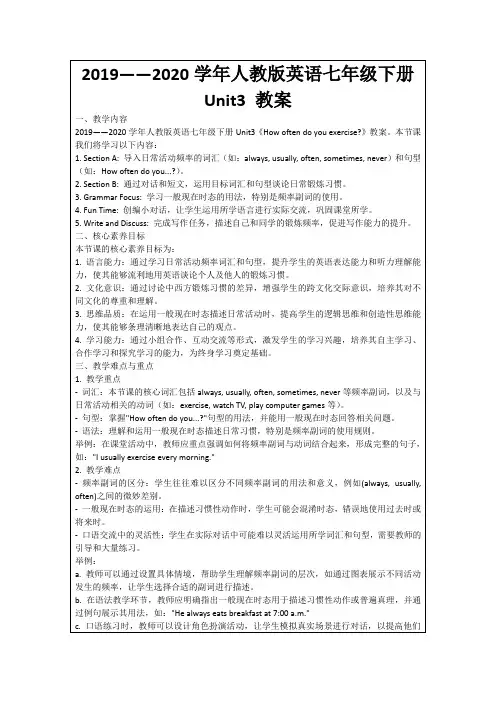
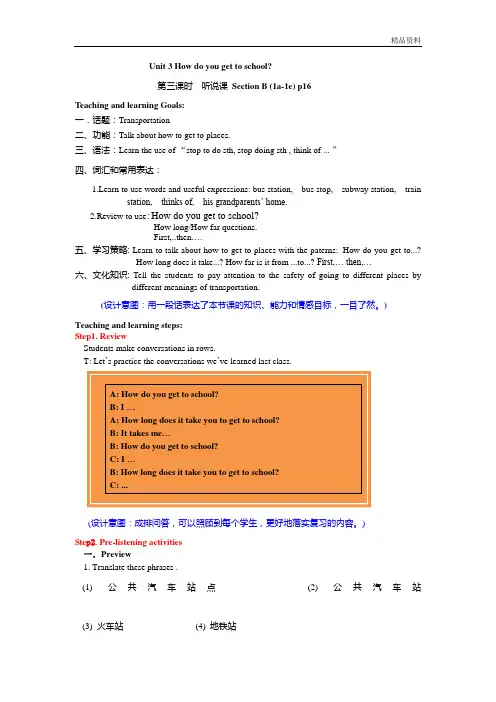
Unit 3 How do you get to school?第三课时听说课Section B (1a-1e) p16Teaching and learning Goals:一.话题:Transportation二、功能:Talk about how to get to places.三、语法:Learn the use of “stop to do sth, stop doing sth , think of ... ”四、词汇和常用表达:1.Learn to use words and useful expressions: bus station, bus stop, subway station, trainstation, thinks of, his grandparents’ home.2.Review to use:How do you get to school?How long/How far questions.First,..then….五、学习策略: Learn to talk about how to get to places with the paterns:How do you get to...?How long does it take...? How far is it from ...to...? First,… then,…六、文化知识: Tell the students to pay attention to the safety of going to different places bydifferent meanings of transportation.(设计意图:用一段话表达了本节课的知识、能力和情感目标,一目了然。
) Teaching and learning steps:Step1. ReviewStudents make conversations in rows.T: Let’s practice the conversations we’ve learned last class.(设计意图:成排问答,可以照顾到每个学生,更好地落实复习的内容。
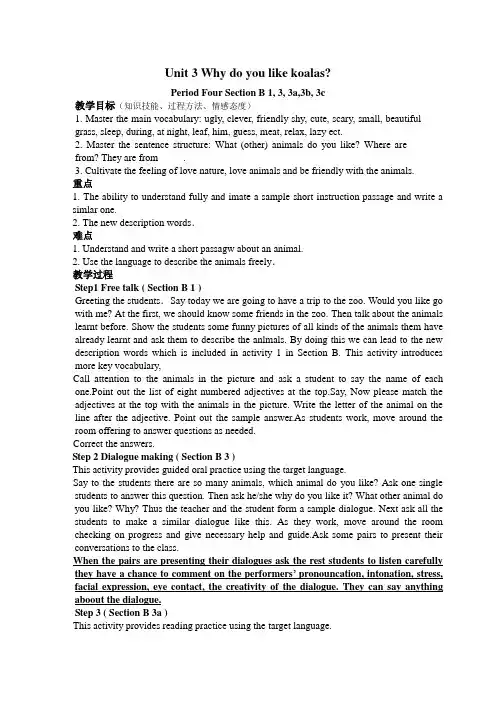
Unit 3 Why do you like koalas?Period Four Section B 1, 3, 3a,3b, 3c教学目标(知识技能、过程方法、情感态度)1. Master the main vocabulary: ugly, clever, friendly shy, cute, scary, small, beautiful grass, sleep, during, at night, leaf, him, guess, meat, relax, lazy ect.2. Master the sentence structure: What (other) animals do you like? Where are __ from? They are from_____.3. Cultivate the feeling of love nature, love animals and be friendly with the animals.重点1.The ability to understand fully and imate a sample short instruction passage and write a simlar one.2.The new description words.难点1.Understand and write a short passagw about an animal.2. Use the language to describe the animals freely.教学过程Step1Free talk ( Section B 1 )Greeting the students.Say today we are going to have a trip to the zoo. Would you like go with me? At the first, we should know some friends in the zoo. Then talk about the animals learnt before. Show the students some funny pictures of all kinds of the animals them have already learnt and ask them to describe the anlmals. By doing this we can lead to the new description words which is included in activity 1 in Section B. This activity introduces more key vocabulary,Call attention to the animals in the picture and ask a student to say the name of each one.Point out the list of eight numbered adjectives at the top.Say, Now please match the adjectives at the top with the animals in the picture. Write the letter of the animal on the line after the adjective. Point out the sample answer.As students work, move around the room offering to answer questions as needed.Correct the answers.Step 2 Dialogue making ( Section B 3 )This activity provides guided oral practice using the target language.Say to the students there are so many animals, which animal do you like? Ask one single students to answer this question. Then ask he/she why do you like it? What other animal do you like? Why? Thus the teacher and the student form a sample dialogue. Next ask all the students to make a similar dialogue like this. As they work, move around the room checking on progress and give necessary help and guide.Ask some pairs to present their conversations to the class.When the pairs are presenting their dialogues ask the rest students to listen carefully they have a chance to comment on the performers’ pronouncation, intonation, stress, facial expression, eye contact, the creativity of the dialogue. They can say anything aboout the dialogue.Step 3 ( Section B 3a )This activity provides reading practice using the target language.Show a picture of the leader of the zoo. And say to the students that the leader come across with some difficulties, can you help him? Then lead to “ Let’s help. (1)”. Say that the three animal instrctions and the animal names are in wrong order because of the heavy rain. Can you help putting them in right order? Then ask the students to resd the three instruction by themsekves and match the instruction with the animals.Check the answers.Say in order to let the visitors fully understand the three animals, let’s make a table to compare the three animals. But the table haven't finished would you please finish it?Give the students some minutes to finish the table then check the answers.Step 4 ( Section B 3b )This activity introduces some new vocabulary words and provides reading and writing practice using the target vocabulary.Say the instruction of the lions is destoried by the heavy rain. Would you please help filling the blanks of the instruction so that the other visitors could know the lions more.Call attention to the pictures of animals in 3a, and draw attention to the grass, leaves, and meat. Ask a student to explain each word or use it in a sentence to show he or she understands what it means. Teach the expression sleeps.Point out the description in 3b with blank lines where some words are missing. Read it to the class saying blank each time you come to a blank line.Point out the six words in the box. Say, You can write these words in the blanks. Use each word only once.As students work, move around the room checking progress and offering language support as needed.Check the answers.Step 5 ( Section B 3c )This activity provides reading and writing practice using the target language.Say the leader of the zoo have another problem. The zoo decided to bring in a new kind of animal that is penguins. But the instruction haven’t been written. Would you please help writing a instruction of the penguins for the zoo. The main features of the penguins are on the screen for you. Then give the students several minutes to write the short passage. While the students are writing, move around the classroom and give necessary help. Ask students to share their writing with others in the class. The other students should comment on the short passage written by one specific student. They can comment on the grammar, the vocabulary, and the structure of the short passage.Step 6 ( Words from the leader )Say the animal are so lovely, right? But ther are some ones always want to hurt the lovely animals in order to make money. Then show the students a picture of a dead elephant whose teeth are taken by someone. Is it brutal? So out leader have words for you. Let’s love animals and be friends with them and love nature. Wuold like to do it?Step 7 ( Homework )1. Finish the exercise book part 5 and 6.2. Copy the new words on page 16 and 17 three times and remember them by heart.3. Find some proverbs concering the animals.。
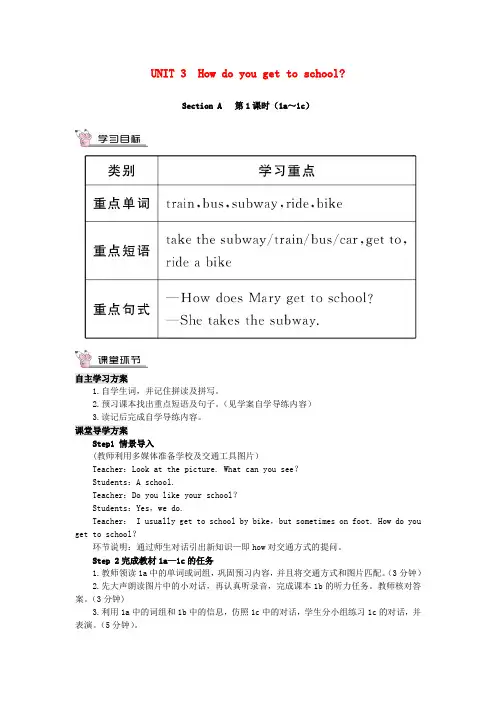
UNIT 3 How do you get to school?Section A 第1课时(1a~1c)自主学习方案1.自学生词,并记住拼读及拼写。
2.预习课本找出重点短语及句子。
(见学案自学导练内容)3.读记后完成自学导练内容。
课堂导学方案Step1 情景导入(教师利用多媒体准备学校及交通工具图片)Teacher:Look at the picture. What can you see?Students:A school.Teacher:Do you like your school?Students:Yes,we do.Teacher: I usually get to school by bike,but sometimes on foot. How do you get to school?环节说明:通过师生对话引出新知识—即how对交通方式的提问。
Step 2完成教材1a—1c的任务1.教师领读1a中的单词或词组,巩固预习内容,并且将交通方式和图片匹配。
(3分钟)2.先大声朗读图片中的小对话,再认真听录音,完成课本1b的听力任务。
教师核对答案。
(3分钟)3.利用1a中的词组和1b中的信息,仿照1c中的对话,学生分小组练习1c的对话,并表演。
(5分钟)。
参考案例:4.小结训练。
(3分钟)(1)一How does your sister get to school?— C .A. Once a dayB. Two milesC. Take the busD. Twenty minutes(2)My brother B to school every morning.A. takesB. walksC. on foot(3)The girl rides her bike to school.(对画线部分提问)How does the girl go to school?环节说明:听说结合,第一时间向学生传达语言目标,通过结对对话练习和小结训练,语言目标得以强化。
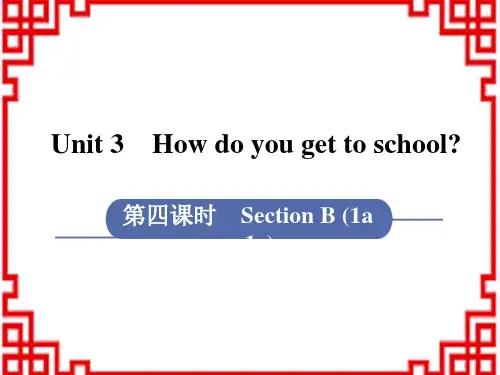


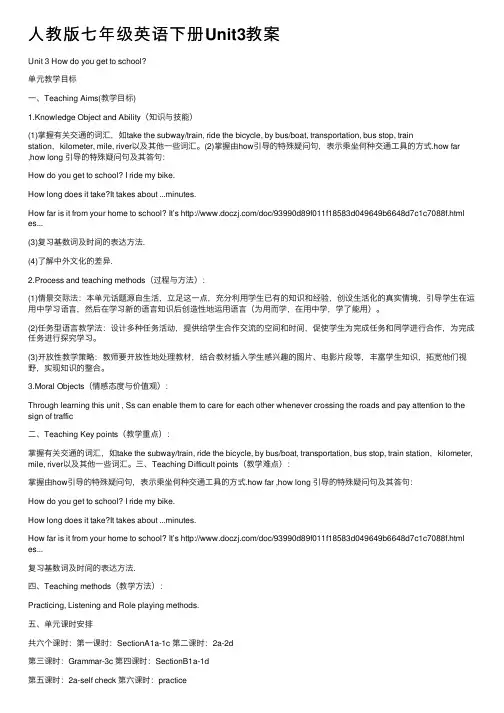
⼈教版七年级英语下册Unit3教案Unit 3 How do you get to school?单元教学⽬标⼀、Teaching Aims(教学⽬标)1.Knowledge Object and Ability(知识与技能)(1)掌握有关交通的词汇,如take the subway/train, ride the bicycle, by bus/boat, transportation, bus stop, trainstation,kilometer, mile, river以及其他⼀些词汇。
(2)掌握由how引导的特殊疑问句,表⽰乘坐何种交通⼯具的⽅式.how far,how long 引导的特殊疑问句及其答句:How do you get to school? I ride my bike.How long does it take?It takes about ...minutes.How far is it from your home to school? It’s /doc/93990d89f011f18583d049649b6648d7c1c7088f.html es...(3)复习基数词及时间的表达⽅法.(4)了解中外⽂化的差异.2.Process and teaching methods(过程与⽅法):(1)情景交际法:本单元话题源⾃⽣活,⽴⾜这⼀点,充分利⽤学⽣已有的知识和经验,创设⽣活化的真实情境,引导学⽣在运⽤中学习语⾔,然后在学习新的语⾔知识后创造性地运⽤语⾔(为⽤⽽学,在⽤中学,学了能⽤)。
(2)任务型语⾔教学法:设计多种任务活动,提供给学⽣合作交流的空间和时间,促使学⽣为完成任务和同学进⾏合作,为完成任务进⾏探究学习。
(3)开放性教学策略:教师要开放性地处理教材,结合教材插⼊学⽣感兴趣的图⽚、电影⽚段等,丰富学⽣知识,拓宽他们视野,实现知识的整合。
3.Moral Objects(情感态度与价值观):Through learning this unit , Ss can enable them to care for each other whenever crossing the roads and pay attention to the sign of traffic⼆、Teaching Key points(教学重点):掌握有关交通的词汇,如take the subway/train, ride the bicycle, by bus/boat, transportation, bus stop, train station,kilometer, mile, river以及其他⼀些词汇。
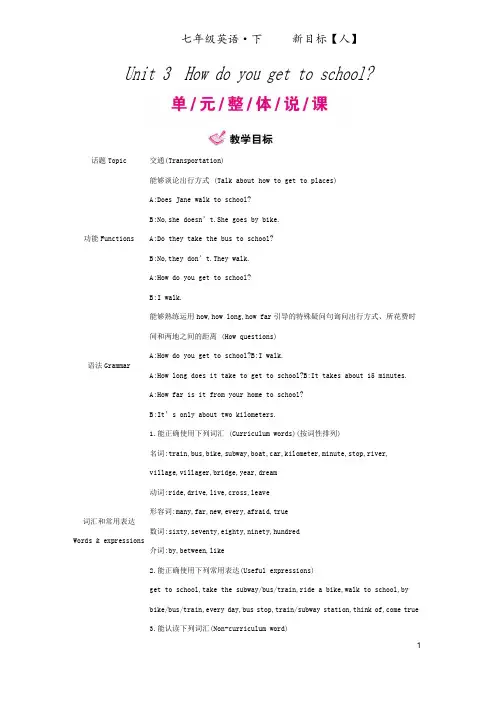
七年级英语·下新目标【人】Unit 3 How do you get to school?1.引导学生能口、笔头熟练地运用表达“乘坐某种交通工具”的名词和动词短语,并用于询问他人和表达自己的交通方式。
2.引导学生正确而熟练地运用句型:How do you/does he go to school?How long does it take?以及How far is it?等对交通方式、用时和距离进行问答。
3.能通过听、说、读等各项课堂活动,提高学生的听、写、记的能力。
4.能运用所学的语言知识进行语言的运用。
教法:以听说领先,在英语语境中大量感知和训练本单元的表示出行方式的句型,养成良好的学习英语的习惯。
通过单元的语言学习,归纳总结关于how,how long 及how far 的用法以及关于花费的用法,使知识的记忆系统化。
采用Pair work 和Group work 相结合的方式,练习询问出行方式的英文句型。
阅读活动设计为“读前、读中、读后”,每一步都设计了不同的任务或活动,重在培养学生的阅读策略和技能,同时结合阅读材料进行拓展性语言训练和运用。
让学生在语言学习的过程中,养成积极参加文体活动的习惯。
教学突破:创设语境,重视听说能力,反复训练询问出行方式。
在练习中正确使用how 及how long 及how far 培养学生对词语及句型的运用能力,为写作练习做准备。
第一课时:Section A 1a —1c第二课时:Section A 2a—3c 第三课时:Section B 1a—2c第四课时:Section B 3a —Self Check英国人的出行习惯首先英国人是有靠左走的习惯,在英国资产阶级革命胜利后第一次工业革命前,由于商业的繁荣,上层社会多用马车出行,如果靠右边行驶,马车夫的马鞭很容易伤到行人,所以英国议会就颁布了一项法令,规定马车必须靠左行驶,此后一直到今天,在英国驾车一直都要遵守此惯例,而现在其他靠左走的国家只是在制定交通规则时,照抄而已,所以开车靠左走,既体现了英国的传统,又体现了对人的关怀!红色双层巴士是英国的重要标志。

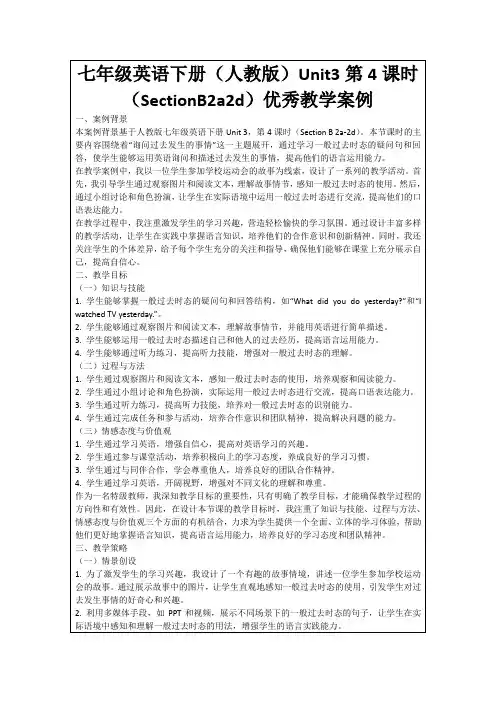
UNIT 10 I’d like some noodles.Section A 第1课时(1a〜1c)自主学习方案1.自学生词,并记住拼读及拼写。
2.预习课本找出重点短语及句子。
(见学案自学导练内容)3.读记后完成自学导练内容。
课堂导学方案Step1 情景导入Everyone has his own taste. So what kind of food do you like? What’s your favorite food?Do you like noodles?What kind of noodles do you like?Today we'l talk about the kinds of noodles.环节说明:就学生感兴趣的身边的话题导入新课,简洁明了,引人入胜。
Step 2完成教材1a—1c的任务1.学生认真观察1a图片中的食物,然后将词语与图片搭配,集体核对答案。
(2分钟)2,老师领读单词,并纠正发音。
(2分钟)3.学生认真听录音,标出顾客所点的面条,集体核对答案,完成课本上1b的听力任务。
(3分钟)4.两人一组练习1a中的对话,然后编新对话进行练习,并请一些学生表演出他们的对话。
(5分钟)参考案例:A:What would you like?B: I,m not sure yet. Are there any vegetables in the mutton noodles?A: Yes,there are some cabbages.B: OK,I’d like the mutton noodles.5.小结训练。
(2分钟)(1)一Would you like some beef?— C .A. Yes,I wouldB. No,I wouldn’tC.Yes, pleaseD. Thanks(2)There are B hamburgers in our restrant. Would you like ?A.some;someB. some;anyC.any; anyD. any;some环节说明:听说结合,第一时间向学生传达语言目标,通过结对对话练习和小结训练,使语言目标得以强化。
第四课时Section B(2a—3b)教学目标通过本课的学习,学生能够:1.获取和梳理本课语篇的信息和涉及的what、how、why句型的关键信息;理解并掌握本课时重点词汇,如cross、river、village、bridge、between…and…等。
(获取信息)2.使用速读、寻读和思维导图的阅读策略对语篇信息进行结构性梳理,并在语境中正确理解和区分词性。
(梳理整合)3.深层思考亮亮上学方式变化的原因,并清楚阐述自己的观点,提高自身思维品质。
(内化应用)4.借助小组活动,合作探究的方式,懂得珍惜自己的生活和学习条件,从而更努力地学习。
(迁移创新)语篇研读What:本语篇介绍了一个偏远乡村孩子亮亮上学的故事,亮亮出生于偏远山区,上学方式艰辛,但他毫无畏惧,热爱校园,热爱老师,热爱学业。
Why:这一题材展现了偏远地区孩子上学的艰苦,目的是为了唤起城市孩子的关注,同时让他们懂得珍惜自己的生活和学习条件,从而更努力地学习。
How:2a在培养学生的预测能力,2b侧重于语篇信息理解,2c活动则利用句子填空的方式来强化、巩固对阅读内容的理解。
教学过程设计理念:以《英语课程标准》核心素养为导向,以单元主题为引领,基于语篇的育人理念,体现《英语课程标准》“学思用创”的英语学习活动观和“教—学—评”一体化设计理念。
教学目标学生活动效果评价Lead-in通过呈现课文标题及图片,引导学生预测文章的大体内容,并利用读前阶段对文段标题及图片的讨论,渗透一部分生词,从而减轻阅读时的生词压力,做好阅读铺垫1.Greeting.2.Show the title and the picture of thepassage.Let students guess what thestory is about.Who are they?They’re going to school on aropeway.Do you think it’s easy forthem?New words:cross the river,bridge,ropeway,dangerous,afraid.教师鼓励学生对课文内容进行大胆预测,根据学生的表现预判学生的能力并了解学生的兴趣,根据学生的回答情况给予帮助和鼓励设计意图通过预测导入本文段主体,并让学生预测文段大致内容,引起他们的思考,激发他们的思维。
第四课时Section B (2a-2c) 课时目标一、根据句意及汉语提示写出单词。
1.Don'tcross(穿过)the street when the traffic lights are red.2.I have many(许多)books.3.I'm afraid(害怕;担心)I can't remember the way.4.She is like(像)her mother.5.He left(离开)the classroom without saying a word.二、写出下列画线短语的汉语意思。
1.There is a very big river between their school and the village. 在……和……之间2.So these students go on a ropeway to cross_the_river to school. 过河3.Can their dream come_true?实现;成为现实教学过程环节1新课导入T:How do your classmates get to school?S1:I asked Mary. She usually walks to the bus station, and then she takes the bus to school.S2:I asked Jim. He always gets to school in his father's car.S3:I asked Lucy. She sometimes takes the subway to school. But she never takes the taxi.T:For many students, it's easy to go to school. But it can be very difficult for some students who live in a small and poor village in some mountain areas of China.设计意图:本环节以师生对话的方式调动学生参与课堂讨论的积极性,一方面帮助学生复习目标语言,另一方面为下个环节的阅读学习作铺垫,自然地导入新课。
Unit 3 How do you get to school?第三课时听说课Section B (1a-1e) p16Teaching and learning Goals:一.话题:Transportation二、功能:Talk about how to get to places.三、语法:Learn the use of “stop to do sth, stop doing sth , think of ... ”四、词汇和常用表达:1.Learn to use words and useful expressions: bus station, bus stop, subway station, trainstation, thinks of, his grandparents’ home.2.Review to use:How do you get to school?How long/How far questions.First,..then….五、学习策略: Learn to talk about how to get to places with the paterns:How do you get to...?How long does it take...? How far is it from ...to...? First,… then,…六、文化知识: Tell the students to pay attention to the safety of going to different places bydifferent meanings of transportation.(设计意图:用一段话表达了本节课的知识、能力和情感目标,一目了然。
) Teaching and learning steps:Step1. ReviewStudents make conversations in rows.T: Let’s practice the conversations we’ve learned last class.(设计意图:成排问答,可以照顾到每个学生,更好地落实复习的内容。
)Ste p2.Pre-listening activities一.Preview1. Translate these phrases .(1) 公共汽车站点________ (2) 公共汽车站__________(3) 火车站_______________ (4) 地铁站__________________(5) 他祖父母家___________ (6) 认为_____________________(7)骑我的自行车(8)坐地铁2. Ask the students to translate the following sentences.(1) Bob怎样到达他祖父母家?_____________________________________________________(2) 首先他从家去火车站。
_____________________________________________________(3) 然后他乘汽车到他祖父母家。
_____________________________________________________(4)然后我坐地铁。
(5)然后我从火车站坐汽车到他们家。
(设计意图:课前对文本中的重点短语和句型有所了解,能够帮助学生课上有针对性的听讲,尤其是4,5句,是听力材料中的句子,提前预习,可以有效地降低听力难度,能帮助学生更好的理解文本。
)二. Warming up and lead-in.Task1. Match the words with the pictures.Bus stop Bus station Subway station Train station Show some pictures one by one, let students tell what it is.Then make a dialogue like this.T: Hello, how do you get to school?S1: By bus.T: Where do you take the bus?S1: At the bus stop.T: Well, I want to go to Beijing, how can I get there?S2: Take the train.T: Where can I take the train?S3: At the train station.T: That’s right. Let’s look at the pictures and match the words with the pictures.Students match the words with the pictures.Task 2. 1b Pair work.T:Look at the picture . It’s me. How do I get to school? First I … Then I …Encourage students to use two different meanings of transportation to describe. First…Then…Practice the dialogue like this:A: How do you get to school?B: Fir st I …. Then I ….Let the students work in pairs and make their own conversations.Finally, ask some pairs to act it out.(设计意图:利用本土的资源展开,学生更容易接受也更感兴趣。
教师引导学生说出到达学校所乘的交通工具,为1c,1d听力做好铺垫。
)Step 3. While-listening activities.1. Listen for the general idea听取大意T: Boys and girls, just now we talked about how you get to school. Now, please look at the boy and the girl, the boy is Bob and the girl is Mary. They are talking about something. Please listen to the recording carefully and find out the main idea of the conversation.The main idea of the conversation is that_______.A. Bob goes to see his grandparents by train.B. Bob usually goes to see his grandparents.C. It’s a long trip from Bob’s home to grandparents’.(设计意图:让学生通过听录音整体感知,并找出谈论的主旨大意。
在听之前先仔细审题,找出需要听的关键词,听听力之前要对学生进行相关听力策略的指导。
这样能提高学生整体理解听力内容的能力,并能提高学生的听力效能。
)2. Listen for the specific ideas听取细节Task 1. Listen and check the things that Mary wants to know.T: Class, please look at 1c,read the sentences silently, please.Mary wants to know…_where Bob lives._how far he lives from his grandparents’ home._how he gets to his grandparents’ home._how long it takes to get to his grandparent’s home._what he thinks of the trip.T: Now, please listen to the recording carefully and check the things that Mary wants to know.Then, check their answers.(设计意图:第二次听,在听之前,引导学生读并理解这些句子,这样有助于学生快速而准确的获取信息。
)Task 2. 1dT: Boys and girls, please listen to the recording again, how does Bob get to his grandparents’home? Check 1 or 2.The teacher should play the recording twice, the first time, listen and check 1 or 2 . The second time, listen and check their answers.(设计意图:让学生通过听录音选出Bob到达他祖父母所乘的交通工具,训练学生捕捉细节信息的能力。
)Task 3. Listen and fill in the blanks.Mary: I love your home, Bob. It’s so__________!Bob: Thanks, Mary. My _______________home is very big, too.Mary: Where do they______________?Bob: Very____________ from my home.Mary: Oh, how far?Bob: It’s about_____________ kilometers from here.Mary: Wow! That’s far.Bob: Yes, it is. So, I go there and see my grandparents __________ one or two times a year. Mary: How do you get there?Bob: I usually take the_____________.Mary: How ___________does it take?Bob: It takes about ____________hours. And then I take a_________ from the ____________station to their home.Mary: Wow. That’s a _________trip.(设计意图:听并填出空缺的单词,此环节在学生掌握文章大意的基础上,深入把握文章具体的细节内容。